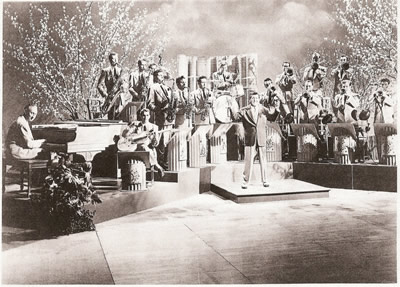| Dan Windolph (Baritone and Alto Sax) has graciously
shared some history of his days with the band. Dan says:
"My first job with Frankie Masters was May 1st
1971, in Louisville, KY.
It was easy to remember, as it was my 4th wedding anniversary,
and
I was gone for the weekend. We played for a Kentucky Derby party
at one
of the big hotels in Louisville, -in a rooftop ballroom on Friday
and
Saturday nights. The name of the hotel escapes me now ... sorry."
"For the, first couple of years after this, I was
a substitute for one
of the Alto sax players, Ted Hess, who regularly went out on tours
with
Wayne King. I was
always happy when Wayne had a lot of work because it
meant I'd work with Frank. In the middle 1970s, some of the regulars
with Frank left the band. Frank had a steady job in the Empire
Room of
Chicago's Palmer House Hotel. It was a great job, as the hand
backed a
lot of great acts and it was good paying, steady work. Frank evidently
got tired of the commute in from his home in the far north suburbs,
and
quit the job. This made a lot of the guys unhappy and they quit
the
band. Luckily, Frank was always able to get good musicians and
the band
didn't suffer any. About that time, the Baritone sax player, Frank
Chizik died. Luckily for me, I play all the saxes, so I wound
up
getting the permanent Baritone sax chair on the band. I still
played
Alto every now and again as there was sometimes some juggling
of
players over the years when someone couldn't make a job. Frank
had the
same problem as any other bandleader in keeping regular personnel
when
the jobs got fewer and guys had to take whatever other jobs they
could
get. Frank managed to work pretty regularly up until the final
few
years when his health began to fail."
"In the final years, Frank started cutting the
band down to just three
saxes in so effort to reduce the cost and to try to get more work.
I
hated that, as I had to double an Alto and Baritone saxes, and
that's
not an enjoyable double for a sax player. On the other hand, I
was
still working."
"Anyway, here's what I can tell you show the years
from 1971 until
Frank's death.
"The band was 3 trumpets, 1 trombone. 4 saxes (
Alto, Tenor, and Baritone ) piano, bass drums, and female vocalist
(besides Frank). If we had a big show, Frank would increase the
size of the band, depending on what was needed. We would add a
second trombone guitar and sometimes a full string section. For
some of the big acts, we would add more brass. I remember doing
this for Mel Torme, Vickie Carr and others. We never added the
other tenor sax though... it was always just 4 saxes. We also
added a Tympani player on a few occasions." "We worked
all of the top rooms in Chicago... Grand ballrooms in the Conrad
Hilton, Palmer House, the Drake, and the Ritz-Carlton. We also
played all the big theatres ... those that were still left, such
as the Auditorium Theatre, the Chicago Theatre, Arie Crown Theatre
at McCormack Place, etc. Frank had a reputation as being a good
show band ... able to back up any act with a minimum of rehearsal.
This was a real factor, as many of the places didn't want to pay
for Rehearsals, so, many times I would see the act's music the
first night we were playing it on the show. I really enjoyed this,
as it made you sit up straight and be a real musician. The band
was one of the best in the business at sight reading music."
"We played mostly country club private dances, parties, etc.
We also played many conventions and political fund raisers. We
did a little traveling, but not much. We flew to Kansas City to
play in a big country club. The band also flew a couple of times
to play Elitch's Gardens, but that was before I joined."
"Some of the acts we played for are: Bob Hope, Mel Torme,
George Burns, Vickie Carr Margaret Whiting, Helen O'Connell, Jim
Nabors, (Gomer Pyle-good singer and a terrific guy), Milton Berle,
Myron Cohen, Jonathan Winters George Gobel, Henny Youngman, Mark
Russell, Phyllis Diller, Phil Harris, the Harmonicats (great musicians
and great guys), Dennis Day, the Step Brothers, the Ink Spots,
Sally Rand, Cab Calloway (fun, fun fun, but some of the hardest
music I ever played), the Smothers Brothers, Victor Borge (one
of the funniest men I ever worked with) etc, etc, etc." The
band personnel as of 1971 was:
Trumpets: Bob Lambkin, Stu Lichte & Bob Haddick
Trombone: Clay Harvey, (Ian Lilly, sub.)
Alto Sax: Roger Malambry Ted Hess (Dan Windolph, sub.)
Tenor sax: Angie Delabadia
Baritone Sax: Frank Chizik
Piano: Art Quinn
Bass: Steve Gocel
Drums: Henry Riggs
|














